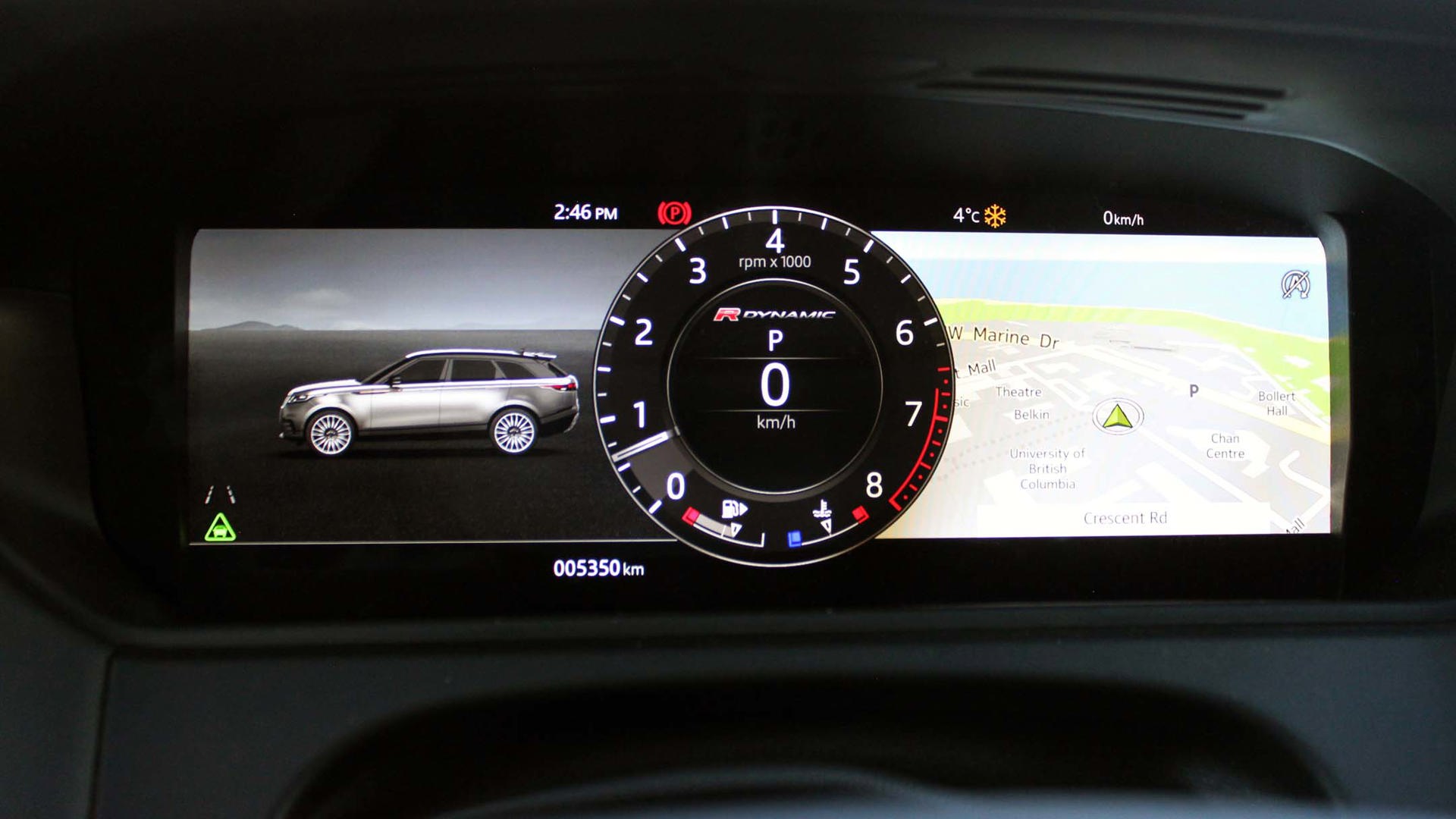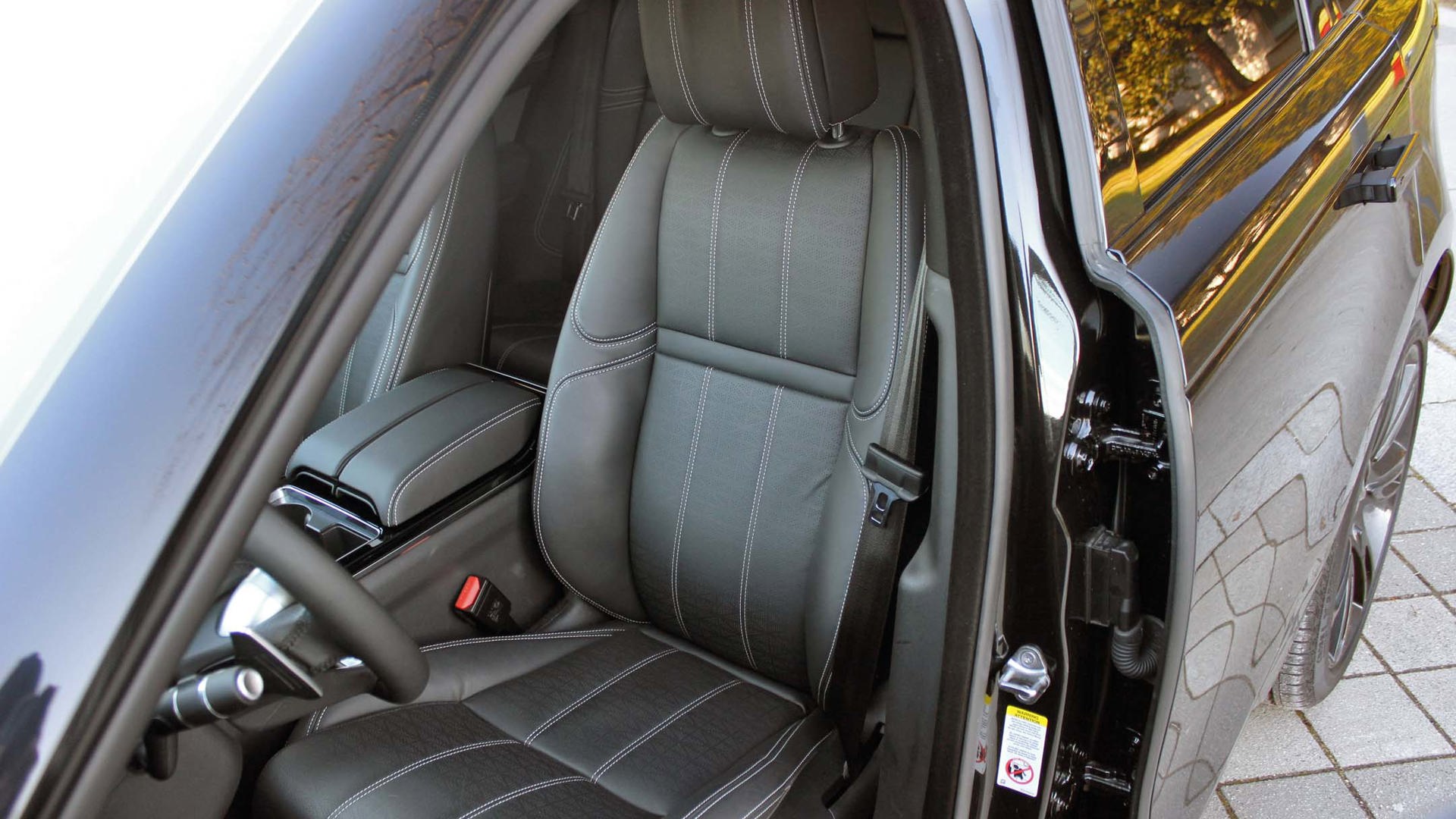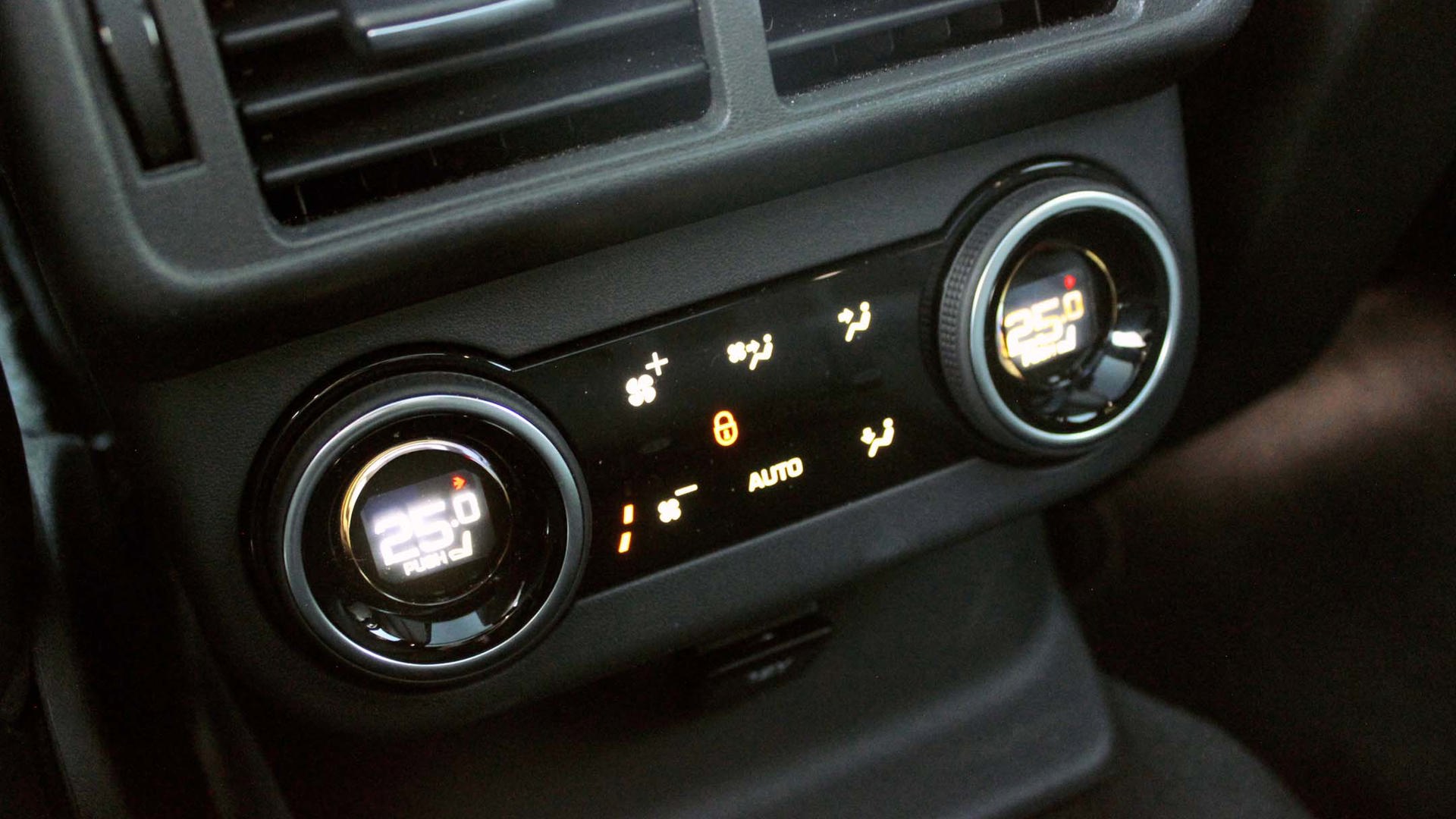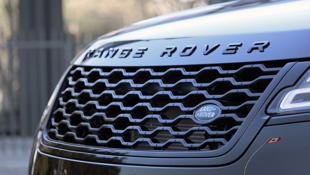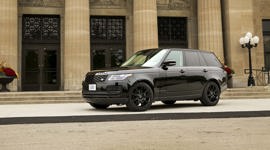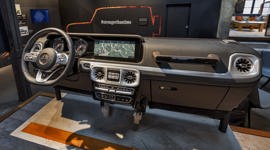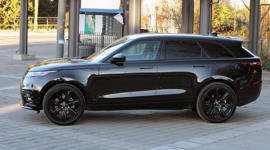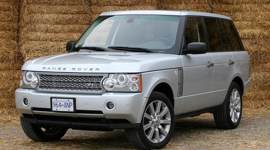 AutoTrader SCORE
AutoTrader SCORE
-
STYLING9/10
-
Safety8/10
-
PRACTICALITY8/10
-
USER-FRIENDLINESS7/10
-
FEATURES8/10
-
POWER8/10
-
COMFORT7/10
-
DRIVING FEEL8/10
-
FUEL ECONOMY7/10
-
VALUE7/10
Approaching my 2018 Land Rover Range Rover Velar tester on a grey December day in Vancouver, reminded me of the Jay-Z lyric “all black everything”. There really is no better way to describe this Kylo Ren of an SUV. Big 22-inch rolling stock: black. Exterior paint: black. Grille: black. Interior: black, with a sprinkling of silver.
Forget “all black everything”; this is “all TFT everything”.
My tester did have the “R-Dynamic Black Package” which adds that grille and a host of other things including blacked-out hood vents, tailgate lettering, and more (those 22s are a separate option, however), but that doesn’t change the fact that this is one sinister-looking luxo-crossover.
Which is a nice fit for the Velar. Range Rover’s latest sits between the plucky Evoque and heavy-hitting Sport in the Range Rover line-up, with a base MSRP that falls closer to the Evoque. To me, that makes sense; the Evoque is youthful-feeling to the point where it strays quite far from the classic Rangie image – traditionally a mix of the rough-and-tumble and luxury of the highest order – and the Velar is here to better bridge the gap between the two.
Size-wise, the chopped roof makes it look longer than it really is, though it’s shorter overall than the Sport, has a shorter wheelbase and is lower, too. It looks properly sporty and aggressive, making for one of the most head-turning SUVs seen on the road today. The way the LED DRLs and taillights contrast so vividly with their black surroundings, the body-colour-matched wing mirrors, rims, and door pulls (that recede when locked, Jaguar F-Type style); it’s eye-catching and while it may be a little too aftermarket – a little too Jay-Z, perhaps – for some, most of those details are optional.
Plus, a lot of that darkness disappears once inside thanks to the Velar’s Touch Pro Duo system. Forget “all black everything”; this is “all TFT everything”. Climate controls? TFT display. Terrain Response 2 AWD mode selection? Same TFT display as the climate controls. Infotainment? TFT display, obvs, but with a twist as it can tilt through 30 degrees. Gauge cluster? TFT display. Add the optional heads-up display (for a gut-wrenching $1,020) and in addition to looking like it belongs to Kylo Ren, he’d be plenty comfortable in this flight-deck interior, too.
Historically I’ve been anti-all-touch surfaces, but these are so responsive and intuitive I didn’t mind them. I did keep a cloth close at hand, though. Plus, traditional knobs sit at the bottom corners of the screen, so you’ve got some of the old mixed with the new.
The gauge cluster is modifiable to the nth degree. You can have nearly the entire screen filled by your GPS map, or you can have a tachometer and a map, two traditional dials, and so on. Range Rover is doing its best to channel Audi’s Virtual Cockpit and they’re doing a pretty bang-up job of it.
I’m not totally sold on it, however. I tried the full map instead of speedometer/tachometer alignment and I found it just a little too in-your-face, especially at night. As cool as it all is, I actually spent most of my drive with the traditional speedometer/tachometer set-up. The other two displays aren’t nearly as oppressive.
When it comes time to set off, the rest of the in-cabin experience comes sharply into focus. The 20-way adjustable seats are a good fit for most any body type, while the optional massage feature up front kicks things up another notch. These are some great chairs fit for luxury motoring and they come standard, along with the full-length moonroof whose shade rolls smoothly back as soon as you start the engine.
Aside from just looking bigger than it is, there’s more rear storage space than there is in the Sport. While there’s slightly more front legroom in the Sport, there’s more rear legroom in the Velar. That chopped top does mean less headroom, though.
There are some ergonomic niggles, too; the way the start/stop button is angled towards the driver makes it more awkward to reach, while the front storage bin is shallow and its dual-lid set-up is a chore to operate. A less cheap-feeling door on the cupholder mounted to the right of the rotary dial shifter would also be nice.
My R-Dynamic tester came equipped with a supercharged V6 shared with the Sport and good for 380 hp and 332 lb-ft of torque, fed through an eight-speed ZF auto. It’s a wonderful engine–transmission combination that doesn’t waste time hunting for gears; it’s good at finding the power-delivery sweet spot, but can also be a fun dance partner if you decide to make use of the satin silver paddles and do the shifting on your own. Indeed, the transmission’s manners actually had me wanting to do this more and more as my test continued.
It comes down to how different the Velar feels depending on which drive mode you’ve selected. Each one is accessed via the lower display, and what appears on the upper display changes depending on which mode you’re in.
In Dynamic mode, for example, tapping a helmet icon on the lower display has the upper screen displaying a G-meter, a throttle level indicator and – wait for it – a stopwatch! Track days ahoy!
When in one of the more off-roady modes such as mud/rut or sand, the screen switches to your wheel articulation indicator, your climb angle and so forth.
Being of the “R-Dynamic” variety, I made sure to spend plenty of time in Dynamic mode, which sharpens throttle response as well as transmission shift times (and keeps a more rear-biased power delivery; it’s a 50:50 split normally, though up to 100 percent of power can be sent to either axle) that have the Velar feeling very quick on acceleration. Being a 2,098 kg crossover that feeling tends to dissipate as you start to throw it into bends, but this remains one of the best-handling SUVs or crossovers I’ve ever tried this side of the Porsche Macan and Cayenne. Body roll is well managed, as is dive under braking.
Thing is, when you’ve got a large vehicle that seemingly bends the laws of physics by handling so well – as well as one that can wade through water 650 mm deep (600 without our car’s air suspension, which comes standard on V6 models) – chances are you’re going to have to make some concessions.
Those come in the form of ride quality. It’s sturdy and confidence-inspiring to be sure, but falls short by just being a little too firm in even the most relaxed driving modes. Expansion joints and the like are simply too readily felt through the seat and steering wheel. Larger, low-speed events such as crossing a speed bump is okay, but once at speed, there’s just a little more cowl shake than I’d like.
You’d think the air suspension would help the situation, but no dice; it’s here mainly for its self-levelling abilities and to make the Velar more efficient. It drops by 10 mm when cruising over 105 km/h to reduce drag, though our observed combined fuel economy of 16.4 L/100 km sat about 5 litres per above Natural Resources Canada’s findings.
As the road gets rougher, however, that kind of ride quality becomes somewhat less paramount. While we didn’t have the chance to do much bouldering – nor will 99 percent of people by the Velar, so there’s that – we did manage to put it through its paces on some snow-slicked roads the likes of which the Velar will often be traversing, especially in Canada.
Before doing so, however, we return briefly to the lower of the two main displays since that’s how you select the off-road modes. Sure, having to first open the drive mode select screen is a bit of a hassle, but I found that once I’d set my climate, the drive mode screen was the one I left on there most of the time. A knob that you just feel for as opposed to a screen you have to look down at would be a little safer, however. I guess Land Rover really believes that the glitz and glamour of a touchscreen will be more of a draw for their target demographic. Plus, my tester’s Terrain Response 2 system features an “auto” mode that automatically monitors current driving conditions and adjusts accordingly, meaning you don’t have to take your eyes off the road at all.
At any rate, drive mode screen activated, I selected “grass gravel snow” and was on my way to slippy oblivion. No matter; as is Range Rover’s purview, power is deftly shuffled between the front and rear axles (as well as between the two rear wheels, a function of my tester’s optional active locking rear differential) and the Velar swishes its way forward, not to be stopped.
It’s out of the slush on the open road, though, where not only did I feel happy, but the Velar did, too. It’s a Range Rover, so it kind of has to have the off-road chops but it’s the dynamic aspects of Rangie’s latest that kept me coming back and wanting to suit up for a drive to… nowhere in particular, really. As long as there was some open road and I could let that great V6 breathe, well, in this car, for this test, that was good enough for me. All the better if there were a couple of curves thrown in, just so I could check, check, and check again that the Velar handled as well as I thought. It didn’t disappoint.
| Engine Displacement | 3.0L |
|---|---|
| Engine Cylinders | V6 |
| Peak Horsepower | 380 hp @ 6,600 rpm |
| Peak Torque | 332 lb-ft @ 3,500–5,000 rpm |
| Fuel Economy | 13.0/10.0/11.6 L/100 km city/hwy/cmb |
| Cargo Space | 673 / 1,985 L seats down |
| Model Tested | 2018 Land Rover Range Rover Velar P380 R-Dynamic HSE |
| Base Price | $82,600 |
| A/C Tax | $100 |
| Destination Fee | $1,600 |
| Price as Tested | $94,500 |
|
Optional Equipment
$10,200 – Santorini Black $670; Convenience Pack (loadspace nets, rear seat remote release, activity key) $510; satellite radio $460; 22” Style 7015 wheels $2,040; heated steering wheel $260; Full Extended Leather Upgrade $990; R-Dynamic Black Pack (fog lights, black finish on tow eye cover, exterior mirrors, tailpipe, Land Rover badge, grille, bumpers, side sills, side vents, hood louvres) $670; HUD $1,020; power socket pack 2 $210; black roof rails $410; configurable ambient lighting $260; Climate Pack (quad-zone climate control, cabin air ionisation, cooled glovebox) $870; On/Off Road Pack (Terrain Response 2, All Terrain Progress Control, Configurable Dynamics) $510; chrome IP end caps $110; 20-way seats + massage + climate front and heated rear seats $510; heated windshield $440; R-Dynamic branded front kickplates $260
|
|





















